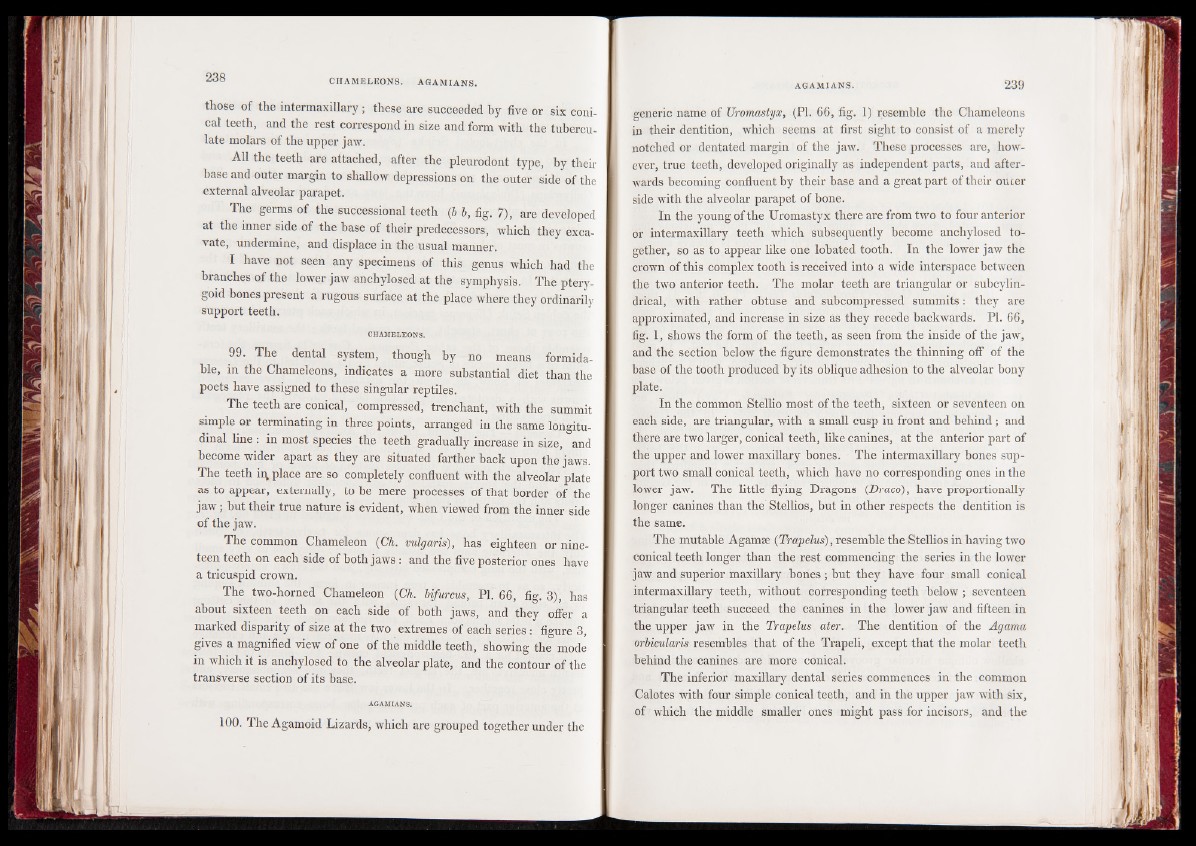
those of the intermaxillary; these are succeeded by five or six conical
teeth, and the rest correspond in size and form with the tubercu-
late molars of the upper jaw.
All the teeth are attached, after the pleurodont type, by their
base and outer margin to shallow depressions on the outer side of the
external alveolar parapet.
The germs of the successional teeth (b b, fig. 7), are developed
at the inner side of the base of their predecessors, which they excavate,
undermine, and displace in the usual manner.
I have not seen any specimens of this genus which had the
branches of the lower jaw anchylosed at the symphysis. The pterygoid
bones present a rugous surface at the place where they ordinarily
support teeth.
CHAMELEONS.
99. The dental system, though by no means formidable,
in the Chameleons, indicates a more substantial diet than the
poets have assigned to these singular reptiles.
The teeth are conical, compressed, trenchant, with the summit
simple or terminating in three points, arranged in the same longitudinal
line : in most species the teeth gradually increase in size, and
become wider apart as they are situated farther hack upon the jaws.
The teeth iq, place are so completely confluent with the alveolar plate
as to appear, externally, to he mere processes of that border of the
jaw; hut their true nature is evident, when viewed from the inner side
of the jaw.
The common Chameleon (Ch. vulgaris), has eighteen or nineteen
teeth on each side of both jaws : and the five posterior ones have
a tricuspid crown.
The two-horned Chameleon (Ch. bifurcus, PI. 66, fig. 3), has
about sixteen teeth on each side of both jaws, and they offer a
marked disparity of size at the two extremes of each series : figure 3,
gives a magnified view of one of the middle teeth, showing the mode
in which it is anchylosed to the alveolar plate, and the contour of the
transverse section of its base.
AGAMIANS.
100. The Agamoid Lizards, which are grouped together under the
generic name of Uromastyx, (PI. 66, fig. 1) resemble the Chameleons
in their dentition, which seems at first sight to consist of a merely
notched or dentated margin of the jaw. These processes are, however,
true teeth, developed originally as independent parts, and afterwards
becoming confluent by their base and a great part of their oUcer
side with the alveolar parapet of hone.
In the young of the Uromastyx there are from two to four anterior
or intermaxillary teeth which subsequently become anchylosed together,
so as to appear like one lohated tooth. In the lower jaw the
crown of this complex tooth is received into a wide interspace between
the two anterior teeth. The molar teeth are triangular or subcylin-
drical, with rather obtuse and subcompressed summits: they are
approximated, and increase in size as they recede backwards. PL 66,
fig. 1 , shows the form of the teeth, as seen from the inside of the jaw,
and the section below the figure demonstrates the thinning off of the
base of the tooth produced by its oblique adhesion to the alveolar bony
plate.
In the common Stellio most of the teeth, sixteen or seventeen on
each side, are triangular, with a small cusp in front and behind; and
there are two larger, conical teeth, like canines, at the anterior part of
the upper and lower maxillary bones. The intermaxillary bones support
two small conical teeth, which have no corresponding ones in the
lower jaw. The little flying Dragons (Draco), have proportionally
longer canines than the Stellios, hut in other respects the dentition is
the same.
The mutable Agamse (Trapelus), resemble the Stellios in having two
conical teeth longer than the rest commencing the series in the lower
jaw and superior maxillary hones ; hut they have four small conical
intermaxillary teeth, without corresponding teeth below; seventeen
triangular teeth succeed the canines in the lower jaw and fifteen in
the upper jaw in the Trapelus ater. The dentition of the Agama
orbicularis resembles that of the Trapeli, except that the molar teeth
behind the canines are more conical.
The inferior maxillary dental series commences in the common
Calotes with four simple conical teeth, and in the upper jaw with six,
of which the middle smaller ones might pass for incisors, and the